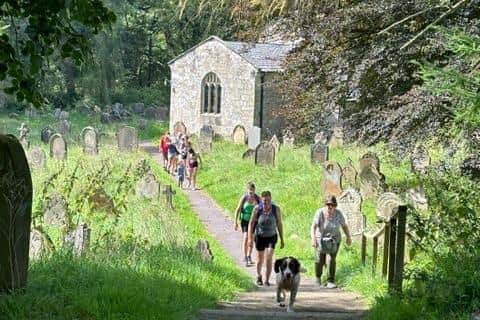North York Moors walks: Villagers who designed their own Yorkshire walking trail plan to expand route after initial success
Earlier this month the Parish of Upper Ryedale held a guided launch of their new Parish Trail, which takes in the villages of Bilsdale, Old Byland, Scawton, Cold Kirby and Hawnby.
Participants raised over £1,600 to go towards the maintenance of the churches – one of which dates back to the Saxon period – and the event was such a success that the North York Moors National Park Authority have agreed to install path markers and advertise it as a permanent trail.
Advertisement
Hide AdAdvertisement
Hide AdThe group’s next step is to connect the trail to the nearest town, Helmsley, and its three hamlet churches at East Moors, Sproxton and Rievaulx – the latter in the shadow of the Rievaulx Abbey ruins.


George Gyte from Upper Ryedale Parish said: “We are thinking of calling the two routes together the Helmsley Pilgrim Trail. It goes in a wide loop all around Helmsley which would be the start and finishing point. It should make an interesting and beautiful weekend of walking and admiring some stunning historic churches for visitors to Helmsley.”
Signposts are expected to be erected later in the autumn once more route testing has been carried out, and the trail has been uploaded to Ordnance Survey. It is being promoted to walkers, runners and cyclists and is suitable for all abilities.
The churches all have colourful pasts. All Saints at Hawnby was ransacked by Scottish raiders before being rebuilt in the 14th century. During World War One, the village men were encouraged to join up by the vicar, whose own three sons were among those killed. A flash flood in 2005 left gravestones flattened.
Advertisement
Hide AdAdvertisement
Hide AdSt Michael’s at Cold Kirby is one of the newest of the five, having been built in 1841. It stands close to an old drovers’ road that William the Conqueror’s army used before it became a main route for Scottish cattle traders driving their stock to market in Malton. The area was also home to an 18th-century racecourse called ‘the Newmarket of the north’.
St John’s in Bilsdale, built in the 1890s by the Earl of Feversham, serves a dale that was so remote that it didn’t even get its first road until the 1930s. The Lords Feversham, of Duncombe Park, insisted that the first telephone box was painted green to blend in with its surroundings, and there was national outctry when BT removed it without permission in 1992, replacing it with a modern kiosk. They were fined, the green booth was allowed to remain and it is now listed. The church never served a large population and was mooted for closure as far back as the 1970s before it was merged with others.
All Saints at Old Byland has Saxon and Norman features, though its exact age has not been established. The village was part of the Newburgh Priory estate until the Wombwell family sold the whole place off in 1922 – farms, a pub, a school and the blacksmith’s forge were all disposed of.
St Mary’s at Scawton was built in the 12th century by the Cistercian monks 30 years before Byland Abbey.
